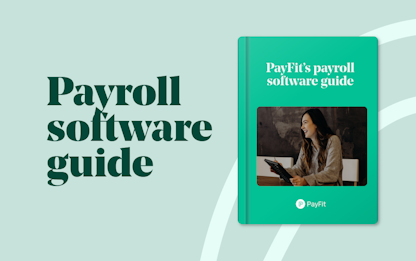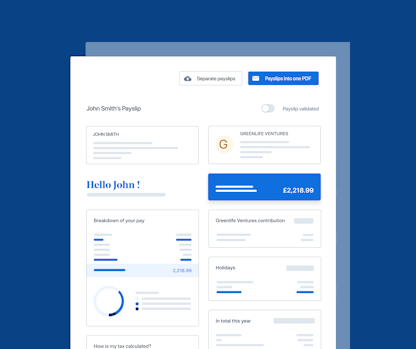- Blog
- |People management
- >Salaries & Benefits
- >Backdated salary
PayFit Explains: What is Backdated Salary?


Keeping up with backdated salary is an essential part of running any payroll process.
From staying on top of salary adjustments to fulfilling requests for back pay, it’s what keeps payroll running smoothly within your company. It also helps keep finances in check while ensuring employees are always fairly compensated for their work.
Back pay in the UK is a complex issue, even if your business is smaller in size. But what is backdated pay, and how does it work? We’ll be going over everything to do with backdated salary, how to calculate it, as well as how our payroll software can help work out back pay in the UK.
What is backdated salary?
Backdated salary, or backdated pay, is the difference between the amount an employee is owed and the amount they actually receive with their payslip.
In other words, backdated salary refers to a change in pay that took place in a previous pay period.
Backdated pay changes include both increases and decreases in salary, and there are many reasons why you might have to adjust salary for an employee.
Why would a salary change be backdated?
From promotions and retroactive salary increases to errors in recording overtime hours, there are lots of different reasons why a salary could get backdated. That could result in an increase or decrease in pay.
Can a pay rise be backdated?
The answer is yes. This is something that happens quite commonly. For example, an employee gets a pay raise effective from March, but this takes time to get processed, so it doesn’t show up until April’s payroll, which means they should get a backdated salary increase or backdated pay rise.
Other reasons a salary could get backdated
These include:
A new salary being agreed upon after the payroll cut-off
Pay missed due to a payroll error
A new employee missing the payroll cut-off
If an employee feels they were wrongfully terminated from their position, they may also request a backdated pay rise after leaving their job.
How does backdated pay work in the UK?
Determining back pay is pretty straightforward if you know how to calculate it correctly (which we’ll break down shortly). Here’s how to determine a backdated salary adjustment needed for a pay change.
How is backdated pay calculated?
First, you’ll need to calculate the difference between the old daily rate and the new one:
Let’s assume you’re doing payroll for November 2021 and that the old salary was
£2 500 per month.
£2 500 * 12 months = £30 000 per year
£30 000 / 52 weeks = £576.92 per week (rounded to nearest penny)
£576.92 / 5 days = £115.38 per day (rounded to nearest penny)
So, £115.38 is the daily rate for the old salary.
And let’s say the new salary has been bumped up to £2 900 per month, effective from the 10th of October, last month.
£2900 * 12 months = £34 800
£34 800 / 52 weeks = £669.23 (rounded to nearest penny)
£692.31 / 5 days = £133.85 (rounded to nearest penny)
So, £133.85 is the daily rate for the new salary.
The difference between the old and new daily rate is £133.85 - £115.38, or £18.47.
Remember that ‘effective from’ date? You’ll need to take the difference you’ve just calculated and multiply it by the number of working days that have passed since this date and the end of that earnings period.
£18.47 * 15 (days from 10th of October to 31st of October) = £277.05
That gives you £277.05, which is the amount of backdated salary you’ll need to pay
How is backdated salary taxed in the UK?
The tax implications of backdated salary will depend on the circumstances surrounding the payment. You’ll also need to consider whether the pay award was made in the current or a previous tax year.
For arrears falling within the current tax year, tax on backdated pay in the UK is due on the earliest of these two dates:
The date the payment was received by the employee or worker
The date when they became entitled to it
For example, an employee may receive a pay award, effective from the 1st of January, but this may contractually be paid in arrears in March. In this case, the tax due on the arrears is calculated in March.
What about NIC implications?
Like tax, the NIC implications on the backdated salary depend on the specific circumstances.
Let’s take the case of an employee missing the payroll cut-off, such as a new starter. The NIC calculated on their back pay should be applied as if it were paid in the month it was due to them.
Are retro pay and backdated salary the same thing?
Yes, employees, managers and other stakeholders may use the term retro pay or retrospective pay to refer to backdated salary. Other interchangeable terms include ‘pay arrears’, ‘backdated pay’, or ‘back pay’.
How long do I have to pay employees?
There is no timeframe during which an employee needs to be paid for their arrears. That is unless there’s a contractual arrangement in place.
For example, if your employee is a new starter and has missed the payroll cut-off for the month, they should be paid in the next payroll run.
Where a payment is made in arrears to an employee, the best practice is to inform them when they can expect the payment, ensuring that all contractual obligations are being met.
Best practices with PayFit: backdated salary
Speaking of best practices, here are some of our top tips for dealing with backdated salaries:
Stay on top of it - Make sure all your data on employee pay rates is up to date as well as previous payslips. PayFit can actually help you do this.
Act swiftly - Once you know you owe or need to adjust backdated salary, start taking steps to update your employee’s next paycheck ASAP. Your employee will thank you for this - especially if it means getting paid on time.
Communicate clearly - Don’t let things get lost in translation. Clear communication helps manage expectations - particularly those of key employees and managers involved. Don’t let this turn into a bigger issue than it needs to be.
Involve your team - Finally, calculating backdated salary can get a little complicated. Sharing this process as something your whole team can get involved with, from HR to accounting and legal, means you can give this issue the attention it deserves.
Introducing: PayFit’s backdated salary feature for UK businesses
Fortunately, keeping up with back pay doesn’t have to be a hassle anymore.
With PayFit’s backdated salary feature, UK businesses can make backdated salary changes anytime.
Just add in your changes and let our software do the rest.
There’s no need for complicated and time-consuming calculations or repetitive rounds of approval through HR, Finance or Payroll. Our software does it all by automatically rebalancing the amount of base pay.
Taxable income, National Insurance and pension contributions are all adjusted for the previous month so that salaries update before your next payroll run.

The 2024 UK National Living Wage - An Employer’s Guide

The Cost Of Recruitment In The UK - What You Might Not Know

UK National Insurance Changes for January 2024

End Of Tax Year 2023/2024 - Eight Key Changes For 24/25

Strategies to Reduce Employee Turnover


